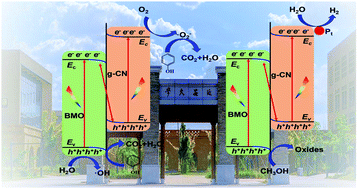Photocatalytic performance and mechanism insights of a S-scheme g-C3N4/Bi2MoO6 heterostructure in phenol degradation and hydrogen evolution reactions under visible light†
Abstract
Photocatalysis with potentially low cost and sustainable utilization is a typically environmentally benign method for the degradation of organic pollutants, but the rational design and fabrication of photocatalysts with high catalytic performance is still an enormous challenge. The efficient segregation of photogenerated electron–hole pairs in photocatalysts is a key and essential factor to decide photocatalytic activity. Herein, a novel Step-scheme (S-scheme) heterojunction photocatalyst, a g-C3N4/Bi2MoO6 (g-CN/BMO) composite, was successfully fabricated using g-C3N4 nanosheet-wrapped Bi2MoO6 microspheres. By adjusting the amount of g-C3N4 in BMO, a series of g-CN/BMO composites was prepared while optimizing posttreatment temperature. The resulting g-CN/BMO indicated well the photocatalytic performance for the degradation of phenol and hydrogen evolution reactions, especially, 100 g of g-CN was integrated into 100 g of the pre-calcined BMO at 200 °C to produce 100% g-CN/BMO-200, showing the highest photocatalytic performance compared to single composite BMO, BMO-200, g-CN, and g-CN/BMO-200 with other mass ratios. Combining the results from the density functional theory calculations and the results of X-ray photoelectron spectroscopy, for S-scheme heterojunction-structured g-CN/BMO-200, the internal electric field-, band edge bending- and coulomb interaction-driven efficient segregation of photogenerated electrons and holes at the interface is elucidated to explain the photocatalytic mechanism, and the resulting holes on the VB of BMO and electrons on the CB of g-CN are responsible for the improvement of the photocatalytic performance. This study revealed that for the S-scheme g-CN/BMO composite the internal electric field, band edge bending and coulomb interaction at the interface between g-CN and BMO can not only promote the effective segregation of electrons and holes, but also retain stronger redox ability. Such an investigation provides a facile and simple strategy to fabricate novel S-scheme heterojunction-structured photocatalysts for solar energy conversion.



 Please wait while we load your content...
Please wait while we load your content...